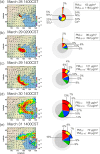Real-time observational evidence of changing Asian dust morphology with the mixing of heavy anthropogenic pollution
- PMID: 28336946
- PMCID: PMC5428416
- DOI: 10.1038/s41598-017-00444-w
Real-time observational evidence of changing Asian dust morphology with the mixing of heavy anthropogenic pollution
Abstract
Natural mineral dust and heavy anthropogenic pollution and its complex interactions cause significant environmental problems in East Asia. Due to restrictions of observing technique, real-time morphological change in Asian dust particles owing to coating process of anthropogenic pollutants is still statistically unclear. Here, we first used a newly developed, single-particle polarization detector and quantitatively investigate the evolution of the polarization property of backscattering light reflected from dust particle as they were mixing with anthropogenic pollutants in North China. The decrease in observed depolarization ratio is mainly attributed to the decrease of aspect ratio of the dust particles as a result of continuous coating processes. Hygroscopic growth of Calcium nitrate (Ca(NO3)2) on the surface of the dust particles played a vital role, particularly when they are stagnant in the polluted region with high RH conditions. Reliable statistics highlight the significant importance of internally mixed, 'quasi-spherical' Asian dust particles, which markedly act as cloud condensation nuclei and exert regional climate change.
Conflict of interest statement
The authors declare that they have no competing interests.
Figures




References
-
- Pachauri, R. K. et al. Climate change 2014: synthesis Report. Contribution of working groups I, II and III to the fifth assessment report of the intergovernmental panel on climate change (IPCC, 2014).
-
- Knippertz, P. & Stuut, J.-B. W. Mineral Dust: A Key Player in the Earth System (Springer, 2014).
-
- Uno I, et al. Asian dust transported one full circuit around the globe. Nature Geoscience. 2009;2:557–560. doi: 10.1038/ngeo583. - DOI
Publication types
LinkOut - more resources
Full Text Sources
Other Literature Sources

